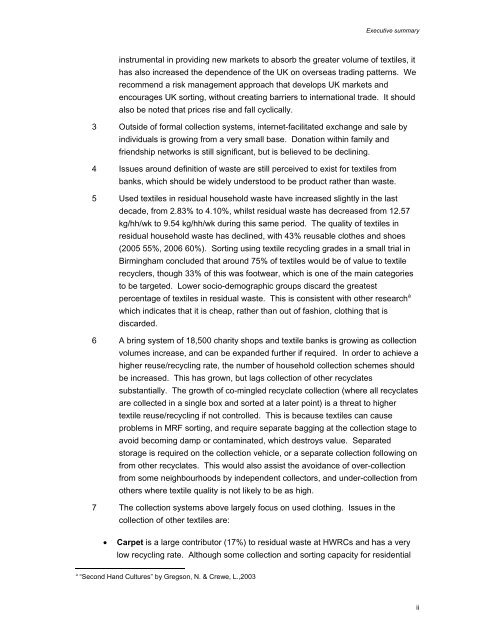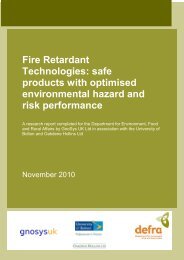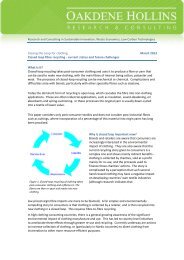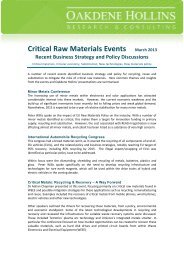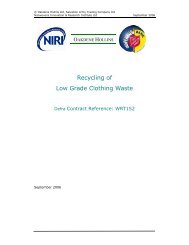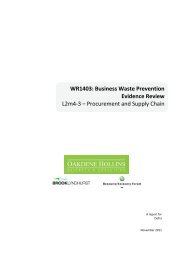Maximising Reuse and Recycling of UK Clothing ... - Oakdene Hollins
Maximising Reuse and Recycling of UK Clothing ... - Oakdene Hollins
Maximising Reuse and Recycling of UK Clothing ... - Oakdene Hollins
You also want an ePaper? Increase the reach of your titles
YUMPU automatically turns print PDFs into web optimized ePapers that Google loves.
Executive summary<br />
instrumental in providing new markets to absorb the greater volume <strong>of</strong> textiles, it<br />
has also increased the dependence <strong>of</strong> the <strong>UK</strong> on overseas trading patterns. We<br />
recommend a risk management approach that develops <strong>UK</strong> markets <strong>and</strong><br />
encourages <strong>UK</strong> sorting, without creating barriers to international trade. It should<br />
also be noted that prices rise <strong>and</strong> fall cyclically.<br />
3 Outside <strong>of</strong> formal collection systems, internet-facilitated exchange <strong>and</strong> sale by<br />
individuals is growing from a very small base. Donation within family <strong>and</strong><br />
friendship networks is still significant, but is believed to be declining.<br />
4 Issues around definition <strong>of</strong> waste are still perceived to exist for textiles from<br />
banks, which should be widely understood to be product rather than waste.<br />
5 Used textiles in residual household waste have increased slightly in the last<br />
decade, from 2.83% to 4.10%, whilst residual waste has decreased from 12.57<br />
kg/hh/wk to 9.54 kg/hh/wk during this same period. The quality <strong>of</strong> textiles in<br />
residual household waste has declined, with 43% reusable clothes <strong>and</strong> shoes<br />
(2005 55%, 2006 60%). Sorting using textile recycling grades in a small trial in<br />
Birmingham concluded that around 75% <strong>of</strong> textiles would be <strong>of</strong> value to textile<br />
recyclers, though 33% <strong>of</strong> this was footwear, which is one <strong>of</strong> the main categories<br />
to be targeted. Lower socio-demographic groups discard the greatest<br />
percentage <strong>of</strong> textiles in residual waste. This is consistent with other research a<br />
which indicates that it is cheap, rather than out <strong>of</strong> fashion, clothing that is<br />
discarded.<br />
6 A bring system <strong>of</strong> 18,500 charity shops <strong>and</strong> textile banks is growing as collection<br />
volumes increase, <strong>and</strong> can be exp<strong>and</strong>ed further if required. In order to achieve a<br />
higher reuse/recycling rate, the number <strong>of</strong> household collection schemes should<br />
be increased. This has grown, but lags collection <strong>of</strong> other recyclates<br />
substantially. The growth <strong>of</strong> co-mingled recyclate collection (where all recyclates<br />
are collected in a single box <strong>and</strong> sorted at a later point) is a threat to higher<br />
textile reuse/recycling if not controlled. This is because textiles can cause<br />
problems in MRF sorting, <strong>and</strong> require separate bagging at the collection stage to<br />
avoid becoming damp or contaminated, which destroys value. Separated<br />
storage is required on the collection vehicle, or a separate collection following on<br />
from other recyclates. This would also assist the avoidance <strong>of</strong> over-collection<br />
from some neighbourhoods by independent collectors, <strong>and</strong> under-collection from<br />
others where textile quality is not likely to be as high.<br />
7 The collection systems above largely focus on used clothing. Issues in the<br />
collection <strong>of</strong> other textiles are:<br />
• Carpet is a large contributor (17%) to residual waste at HWRCs <strong>and</strong> has a very<br />
low recycling rate. Although some collection <strong>and</strong> sorting capacity for residential<br />
a “Second H<strong>and</strong> Cultures” by Gregson, N. & Crewe, L.,2003<br />
ii


